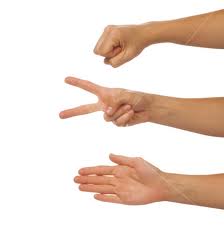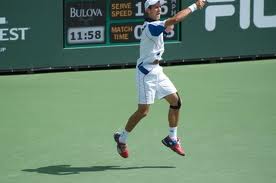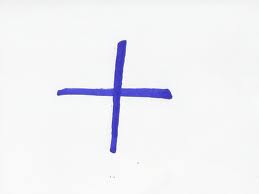Rock Paper Scissor Strategy
 Friday, January 13, 2012 at 01:19PM
Friday, January 13, 2012 at 01:19PM  CAtennis
CAtennis  "If I beat Johnny and Johnny beats Bobby, why do I always lose to Bobby?" Sound familiar? If you're a junior - or even a developing adult player - this type of thinking will have crossed your mind at one point or another in your tennis career. It is attractive to think that, just because you're better than player X (objectively or in terms of ranking), and player X defeats player Y on a regular basis, you are automatically entitled to a win over player Y. The sooner you learn to get out of this mental quicksand, the better player you will become.
"If I beat Johnny and Johnny beats Bobby, why do I always lose to Bobby?" Sound familiar? If you're a junior - or even a developing adult player - this type of thinking will have crossed your mind at one point or another in your tennis career. It is attractive to think that, just because you're better than player X (objectively or in terms of ranking), and player X defeats player Y on a regular basis, you are automatically entitled to a win over player Y. The sooner you learn to get out of this mental quicksand, the better player you will become.
You see, when it comes to tennis, there are several factors that need to be evaluated before determining whether you should take a win over player Y for granted. For example, you may possess a huge serve while player X has only a spin serve. Although on paper it may look like you should have no problems holding serve against player Y, the reality is that player Y may love returning big, flat serves and may have difficulty adjusting to kicks and slices. Also, where you may be a righty, player X may be a lefty. This is only the tip of the iceberg but in terms of winning and losing you must objectively evaluate your game, player X's game as well as player Y's game to determine how X beat Y and what kind of trouble player Y may give you given your game.
Let's delve even deeper into these concepts by looking at three examples. Player X is a counter-puncher; a pure defensive player. Player Y is an aggressive baseliner; he is comfortable at the baseline (perhaps right on top of the baseline) as well as at the net. Player Z is a pure serve-and volleyer; he looks to get in every chance he gets. For purposes of this example, let's also assume that the players are closely matched in terms of results and rankings. From experience, we have found the following to be generally true:
1. Player X (grinder) will generally beat Player Y (aggressive baseliner). Reason: although player Y is comfortable at the baseline, Player X is a baseline specialist who can run shots down all day and not miss. He has more stamina and more patience. Long points and longer matches (especially in tough conditions) do not bother Player X at all. The longer the match goes on, the more confidence is gained by Player X. Player Y does venture into the net once in a while but, not being a volley specialist, he wins as many points from inside the service line as he loses - resulting in frustration and over-hitting (just what Player X wants). Althoug the match is close, Player X usually snatches victory from the jaws of defeat.
2. Player Y will beat Player Z (serve and volleyer). Reason: Player Y is more comfortable at the baseline that Player Z. The shorter points - which offer lots of tagerts - are just what Player Y desires. Player Y loves to thump weak pop-ups and he zeros in on openings like a sniper. Player Y is also skilled at coming in and manages to steal some points that way from Player Z. Player Z seeks to come in but, by having Player Y "hug the baseline", he is forced to come up with better serves and tougher volleys under pressure. With flatter shots from Player Y (i.e., enough topsin to clear the net and then dip), Player Z has less time to come in and must make contact with the volley further back than normal. Sometimes, Player Z will be forced to stay back where he is like a fish out of water. Unless Player Z serves and volleys well beyond his skill level, chances are that Player Y will run away with the victory.
3 Player Z will beat Player X. Reason: Player X is playing further behind the baseline than Player Y would. Therefore, Player Z has a split-second longer to come in and punch the volley. By being closer to the net, Player Z is in better position to open up the court and, as a result, he forces Player X to cover more ground. Sure, Player X will hit some tough passing shots here and there. However, with his loopy topspin, they are too few and far between. Player X is fighting a losing battle where he has to work extremely hard for every point just to have a fighting chance. All this time, Player Z chops him up with solid serves and deft volleys. Player X lacks the opportunity to "get in a rhythm"; the points are simply too short for this and he is forced to hit against a skidding ball (as opposed to a ball with some topsin that would be hit by someone like Player Y).
With the foregoing in mind, the general advice would be to (1) determine how you win and how you lose; (2) determine how your peers win and how they lose (evaluate the information objectively and in a cold and calculating manner); (3) understand that, despite your rankings, you are fallible (definitely not immortal); and (4) practice mastering every gamestyle so that you can apply it when necessary. As you play, keep your eyes open and stay cool-headed so that you can shift strategies as necessary. Try to refrain from pigeonholing yourself as either this type of player or that. Be malleable; do not impose limitations upon yourself. By remaining flexible in your thinking and playing you will be in a better position to utilize the correct tool(s) for the job.
To assist you, keep the following quote by Bruce Lee in mind:
“Empty your mind, be formless, shapeless - like water. Now you put water into a cup, it becomes the cup, you put water into a bottle, it becomes the bottle, you put it in a teapot, it becomes the teapot. Now water can flow or it can crash. Be water, my friend.”





